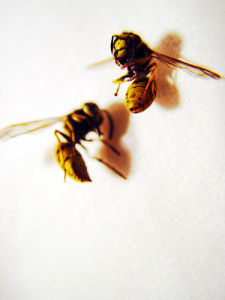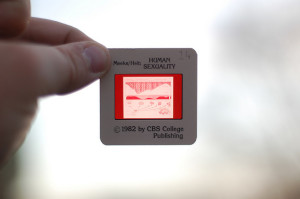Sex education has its flaws.
I never had an opportunity to take sex ed during my time as a junior high school student. But even if I did, I probably wouldn’t have got anything more than what I was able to learn about sex from sources outside of school.
It wasn’t that I was denied access to the class. Sex ed was offered during the Seventh Grade and I happened to skip the Seventh Grade (to catch up from repeating kindergarten). However, many students on the autism spectrum have been denied access to a well-rounded and inclusive sex education. Dave (my partner) was denied from taking a marriage & family planning class in high school because the faculty assumed it wouldn’t apply to him… even though he had expressed interest in taking the course.
I’m sure Dave is looking forward to sending that marriage class instructor a future wedding invitation.
A well-rounded, inclusive sexuality education for individuals with ASD is essential. Even when parents, professionals and educators are providing that education, some vital components are still left out. The autism spectrum is extremely diverse, and developing a universal sex education curriculum that would apply to all is no easy task — if that task is even possible. But regardless of the individual and the way that autism is experienced, there are at least 9 things you must include when developing a sexuality education curriculum for individuals with ASD.
1. Personal Perspective
Without personal perspective insight, developing an effective sex education curriculum for adolescents and adults on the spectrum is impossible.
[pullquote]How often do we come across a self-advocate presenting a workshop on autism and sexuality? Notice how the majority of these presentations are delivered by a professional?[/pullquote]The number of workshops and conference presentations on autism and sexuality are gradually increasing. This is a good thing. What remains to be interesting, based on observation, is the ratio of professionals to personal perspectives on that particular topic. How often do we come across a self-advocate or family member presenting a workshop on autism and sexuality? Notice how the majority of these presentations are delivered by a professional?
Professional perspectives can be highly valuable. Professionals can offer structure and guidance into building a sex education curriculum. Implementing an appropriate methodology, however, requires a significant contribution by a ‘chorus’ of personal perspectives.
Research, studies and workshops which are solely professional-based are, in my opinion, quite fascinating.
2. Personal Perspective
No… this is not a typo. I am actually repeating this one. It is that crucial.
I once had a presentation proposal on autism and sexuality rejected with the following explanation: “We have an expert and respected professional in the field who submitted a presentation on autism and sexuality issues.. so we’ve got that covered.”
Totally covered?
It doesn’t matter as much to me whether my own personal insight is disregarded. What I’m more concerned about is the other individuals’ contributions and insight. Exploring blogs on the Internet, having face-to-face conversations, and attending workshops, we are able to collect a wealth of autistic perspectives on sex education issues. Because the sex education curriculum must be tailored to the autistic individual, it requires that ‘chorus’ of personal accounts of the very individuals who experience sexuality themselves. The larger and diverse the representation, the higher quality education we will be able to deliver to learners on the autism spectrum.
It is beyond amazing to me how personal perspectives are still not taken as much into serious consideration as they need to be. In reviewing reports, published studies, and a selection of the sex education workshops I have attended, it is evident that the sex education model for students with ASD is still dominantly influenced by the Medical Model of Disability. Very likely, this is not deliberate. It’s just a matter of shifting the paradigm in how we as a society perceives individuals with disabilities. Personal perspectives would never allow the Medical Model of Disability to dominate sexuality instruction.
3. Inclusion
Inclusion of learners who are not sexually active or not interested in sex
There are still plenty of health care professionals and educators who assume that individuals on the autism spectrum, or any disability, have no interest in sex or will never have sex. While it’s true there are autistic individuals who will never develop an interest in sex, we cannot make this assumption prematurely.
Even when there are cases when it’s certain an individual will never be sexually active, it is still important to be educated about sex… especially on experiencing changes during puberty, advocating our rights to personal safety and developing sociolsexual awareness (we will cover more on this later).
Inclusion of learners who use non-traditional communication methods
 It is also crucial to develop lesson plans which includes people who do not speak and do not use a communication device (like my brother, James). People with significant communication issues are more likely to be taken sexual advantage of.
It is also crucial to develop lesson plans which includes people who do not speak and do not use a communication device (like my brother, James). People with significant communication issues are more likely to be taken sexual advantage of.
Also, just because one does not speak does not mean one cannot experience sexual pleasure or have a satisfying sex life.
One promising past initiative was the Speak Up Project: a 2004 effort based in Canada. This project focused on addressing the needs of people who use AAC systems to access resources and information on sexuality and receive an adequate sexual health education (a type of access that the verbal speaking population takes for granted). As the project beautifully states on their website: “We all have a role to play in supporting AAC users in developing a sense of sexual identity, confidence and dignity.”
Inclusion of learners who do not fit the heteronormative assumption
Formal sexuality education tends to be strictly focused on a heteronormative assumption. In other words, sex education tends to focus on only two types of individuals: cisgender straight women and cisgender straight men: two ‘complimentary’ genders, according to societal norms. John DeLamater points out in an essay that it “prevents sexual interactions and relationships from moving toward equal contributions, equal responsibility, and equal pleasure” (source: DeLamater: Gender equity in formal sexuality education)
Although the conversation is starting to include more representation of gay, lesbian and bisexual populations, a sex education which is inclusive of gender-variant, intersex, and transgender populations are lacking. Even between the two fundamentally assumed distinct forms (male and female), there are varying degrees of difference among the millions of people who identify as male or female.
Sex education needs to include discussions on embracing and acceptance of sexual orientation and gender expression. Those of us who do not identify with gender norms have the same entitlements, protections and sexual rights as any other human being.
In order to shift out of the heteronormative assumption, we need to be able to identify the social norms (the “unwritten rules” of social behavior) which hinder us.
Social norms may include things like:
- Traditional gender roles
- Heterosexual relationships and marriages
- Cisgender privileges
- Males as masculine and females being feminine
- Society’s definition of beauty
- Privileges of straight, non-disabled status
- Able-bodiedness
Please keep in mind: inclusion is just not restricted to the learning environment where the learner is receiving sexuality education. Inclusion is not a place. Inclusion is a philosophy.
4. Teaching materials for non-traditional learners
 Textbooks are useful for some learners, and not as useful for others. It’s time to take a more creative approach.
Textbooks are useful for some learners, and not as useful for others. It’s time to take a more creative approach.
Here is a condensed list of examples of non textbook-based learning materials:
-
Illustration cards and vocabulary sets for AAC communicators (one resource to check out is Institute on Disabilities at Temple University)
-
Sign language
-
Photos / Videos
-
Puppets (one example is the Wondrous Vulva Puppet)
-
Stick figures (check out this image gallery at About.com Sexuality)
-
Role playing
-
Self defense techniques
-
Interactive demonstrations
-
Sensory integration
6. Sociosexual awareness
Having a knowledge of the sociosexual behaviors means having knowledge of the interpersonal aspects of sexuality. When we are studying sociosexual behavior, we are studying the languages of human social behavior and human sexual behavior. It involves a thorough observation into the sexual-related social interactions within our surroundings. The goal of sociosexual awareness is not to force ourselves into conforming to the social norm, but to gain a better understanding of the “hidden agendas” (hidden sexual intentions) so that we can better protect the vulnerabilities we may have.
In my experience, it is often difficult to recognize when someone is making a move on me, unless the indicators are extremely dramatacized like those “vintage” TV romance flicks. Even if I am hanging out in a bar (a place where a lot of flirting occurs), it has been difficult for me to tell who someone is actually flirting.
6. Sex Positivity
The sex-positive movement is a gradually expanding movement. Even more gradual is the sex-positive movement as it applies to the autism and disability communities.
Of course it’s important to address sexual safety practices. We definitely need to know how to protect ourselves from STIs / STDs, unwanted pregnancy and sexual assault. But it is also important to know strategies for sexual pleasure. We need to understand there is no guilt or shame involved in wanting sexual pleasure and exploring our own bodies.
[pullquote]Expressions of sexuality is not forbidden and evil, but a natural part of the human experience.[/pullquote] It’s also important to know that it’s okay if we don’t want to get involved in sexual activity. We’re often expected to enjoy sex. We’re taught to respond appropriately to societal norms in sexual interactions. Truth is, not everyone is interested in having sex and/or romantic relationships. It’s important the learner needs to understand while we have those rights, we should not be forced and it’s okay to not be interested.
Sexuality in pop culture can portray unrealistic ideas on what is defined as sexy or beautiful. In the social norm, there is a narrow gap of what is considered sexy or beautiful. While it may be useful to learn to identify the stereotypes of what is defined as sexy or beautiful, we cannot be forced to adhere to these stereotypes.
It’s important for individuals to know that…
- Sex is healthy, so long as it is practiced safely and with consent.
- Not having an interest in sex is perfectly okay.
- We have the right to refuse any sexual activity we do not want to participate in.
- We have the right to communicate and be educated about sex in a safe social environment.
- Expressions of sexuality is not forbidden and evil, but a natural part of the human experience.
If you need a clearer idea of the sex-positive movement, here are a few links:
Sex-positive movement (Wikipedia entry)
The Language of Sex Positivity by Charlie Glickman | Electronic Journal of Human Sexuality, Volume 3
8 Ways to be Positive You’re Sex Positive | The Frisky
7. Concrete, specific instruction style
Avoiding euphemisms
 Avoid euphemisms and metaphors if at all possible. Although some of us are able to understand euphemisms, it’s difficult for many of us to get an understanding of the topics at hand. Euphemisms are far too abstract.
Avoid euphemisms and metaphors if at all possible. Although some of us are able to understand euphemisms, it’s difficult for many of us to get an understanding of the topics at hand. Euphemisms are far too abstract.
One example of a euphemism is the popular way to describe sexual reproduction: the birds and the bees. Parents and educators may have the impression that euphemisms are a less intimidating way to teach explicit topics… like sex. Parents and educators also feel it is less intimidating (and more comfortable for them) to approach those topics. As uncomfortable as you may feel, it is best to just stick with the technical terms as this will be an easier way for autistic learners to grasp the topic. Throwing in words like penis and vagina is not going to kill* anyone.
How did the phrase “the birds and the bees” get incorporated as a way to describe sex, anyways?
* figurative speech
Explicit & scientific terminology
Need we say more?
Access to educational resources which contain bullet points, lists, visuals, etc.
Again, self-explanatory.
Mixture of one-on-one and peer group instruction
Individuals on the autism spectrum benefit greatly from one-on-one instruction. This includes sex education. It’s also beneficial to include a class of peers learning alongside the individual, especially when participating in role-playing scenarios, demonstrations and discussions. For non-disabled peers, it reinforces understanding in least restrictive environment (LRE) and the importance of including individuals with disabilities in the classroom. Non-disabled peers need to understand that individuals with disabilities have a right to learn about sex, too.
Candid, clear-cut communication between the instructor and the learner
In addition to that, establish concrete specifics on when and whom to approach to ask questions or express concern regarding sex and sexuality.
8. Safe Learning Environment*
In a safe learning environment…
- The learner will always need some extent of control.
- Instructors need to be approachable, open-minded and receptive.
- The learning environment accommodates the learner’s sensory wiring.
- The learning environment is least restrictive.
Most importantly, learners must feel safe to open up about any questions or concerns they have about sex and not be judged.
*A safe learning environment is not to be confused with a sheltered learning environment.
9. Shift in perception
A shift in perception involves one simple thing: deleting the Medical Model of Disability.
What implications are involved in applying the Medical Model into sex ed? If sexuality instruction is dominated by the Medical Model, it can spark significant negative consequences to the individual. The Medical Model can imply that…
- All individuals on the spectrum have no interest in sex.
- All individuals do not have the capability to take in huge topics like sex.
- All individuals lack empathy.
- The assumed lack of empathy opens up the possibility that we are more likely to become predators or be extremely naive.*
*The four bullet points above are examples of false assumptions people can have on individuals with ASD.
[pullquote]We are often more capable than we realize — regardless of our learning style, cognitive ability, characteristics and complexity of understanding.[/pullquote]The concern of applying the Medical Model of Disability into the sex education curriculum is that the learner is perceived as having to be fixed. It suggests the learner has to convert to as much to the social norm as the parameters of their ability allows. This can result in the individual losing their sense of self worth and identity. This can also lead to the individual not understanding the true meaning of consent — that it’s okay to not accept anything they do not want to get involved in. This can apply to both sexual and non-sexual situations.
Even when there is acknowledgement in existence in sex drive and sexual urges, it may be assumed that autistic individuals lack empathy. This is far from the truth.
It’s important for individuals to know that…
-
We are not victims.
-
Plenty of us do experience the same feelings of romance, sexual desires, developing relationships, and raising a family.
- All labels, classifications, and stereotypes, and conditions are merely labels created by a history of societal norms and were not created naturally.
The Social-Relational Model and the publication The Sexual Politics of Disability (Shakespeare, Gillespie-Sells & Davies) may have opened up the conversation on shifting sexuality and disability out of the Medical Model and portraying sexuality and disability as a civil rights issue. But we are far from having shifted out of that paradigm.
In Closing…
 Autistic individuals tend to be “hands-on” learners. We learn by exploring into our own capabilities in our own bodies. While our physical makeup do vary, I often find that we are often more capable than we realize — regardless of our learning style, cognitive ability, characteristics and complexity of understanding.
Autistic individuals tend to be “hands-on” learners. We learn by exploring into our own capabilities in our own bodies. While our physical makeup do vary, I often find that we are often more capable than we realize — regardless of our learning style, cognitive ability, characteristics and complexity of understanding.
I am not an educator, but it does not take an educator to know that developing this specialized curriculum is extremely difficult. A friend of mine made a good point that “It would have to be incredibly personalized”. Considering the learning styles, communication styles, sensory wiring and levels of comprehension — how does one develop an effective sex education curriculum for learners on the autism spectrum?
The sex education curriculum, ideally, would be constructed as a framework. A framework offers ‘spaces’ to fill in the methods of instruction that would be found ideal for the individual’s parameters of learning ability. These ‘spaces’ can be filled in with the help of IEP meetings, caregivers in adult residential programs, intervention specialists who work directly with the learner, and, of course, significant input from individuals on the autism spectrum.
It may take more time to figure out this process. It’s possible we may not ever reach a point of solidifying a sex education curriculum. But as long as we at least include the components discussed here.. we will at least be on the right track.
In acquiring a well-rounded inclusive sex education, in however way we learn it, we can become empowered.
Image credits: chrisjtse, United Nations Photo, días de viaje*, drp, kid_entropy
